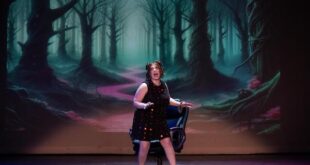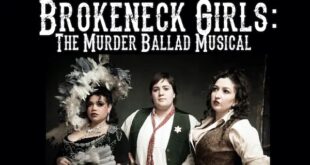
Flappers, burlesque queens, songstresses, a live jazz band, taxi dancers, bootleg liquor, billiards, seances, spirit photographers and ghost hauntings, a mummy thief, coppers and private eyes, poker games, Tarot/Ouija readings, a puppet show, and dramatic episodes culled from the famous Booth family in the time before the Civil War. These fascinating events and activities and the occasion to solve a true-to-life mystery about the Booth brothers, Edwin and John Wilkes, are the stuff of The Speakeasy Dollhouse: The Brothers Booth, an immersive phantasmagoria conceived and created by Cynthia von Buhler, directed by Wes Grantom and presented by Stageworks Media.
Whether you come as an observer or as a participant dressed in the latest 1919 fashions, there is a caveat: Be ready with an open, “anything can happen” sensibility. Only then will the spirits of wonder and playfulness and Cleo, the muse of history sweep you up, altering your sense of time and place from the present-day Players Club back to 1919 and the splendid interior of that Greek Revival mansion Edwin Booth established as a prestigious private club.
In 1919 the Volstead Act – Prohibition – was passed. And on this particular evening, November 13, 1919, Edwina Booth Grossman (Samantha Rosentrater) is celebrating with friends, notaries and city officials the unveiling of the bronze statue of her father. Edwina is the daughter of Edwin Booth (Eric Gravez), the renowned Shakespearean actor and sibling of John Wilkes (Ryan Wesen), notorious assassin of President Abraham Lincoln. Edwina tells the crowd that Edwin Booth’s statue, which presides adjacent to The Players Club in the center of Gramercy Park, is a reminder of her father’s goodness and generosity. He purchased the mansion, kept a room for himself on the top floor, and had the building refurbished as a social club for his fellow players, future actors, writers and others who would be comforted by a social club devoted to artists and elite gentlemen who could mingle and discuss their projects and exploits.

The significance of this unveiling is not lost on the 21st century crowd milling around the ballroom. It is at the unveiling that the Speakeasy Dollhouse production begins, amidst cries of newsboys about the Volstead Act and about the theft of the John Wilkes Booth mummy from the circus. Guests understand that during this immersive, zany and highly imaginative extravaganza, they are the current performing artists who receive the largesse of Booth’s endowment. It is an irony as sumptuous and lush as the chandeliers, furnishings, rare books and costly paintings that, along with the ghosts, inhabit this luxuriously appointed Stanford White architectural standout.
Dressed in their finery and ready to celebrate, the crowd saunters from room to room, investigating the activities in the Booth mansion. Some have traveled upstairs where Mark Twain (Lord Kat), a member of The Players, conducts a poker game and sharpens his skills on unwary, inexperienced players. Some visit the downstairs club area where they see John Singer Sargent (Sargent painted the oil of Edwin Booth which hangs in the club) and a friend play billiards. Others enter the library to watch an example of a typical 1919 entertainment, a puppet show, “Obligate Siblicide on the Galapagos Islands.” Other guests indulge in a seance.

It is in the seance room where the action begins to boil over. For the seance raises the spirits of the Booth family. The ghostly Brothers Booth play out their conflicts and struggles for supremacy. Throughout the evening episodic quarrels explode, and we see their bitter rancor and jealousy play out in the larger rooms of the opulent mansion. Strangely, the puppet show’s concept about how a booby chick devours its sibling in competition for food is reminiscent of the theme of fierce competitiveness between the Booth brothers. The puppet show thematically mirrors the ghostly enactments; in both there is a devouring quality. The Booth brothers’ destructive rivalry and its outcome is foreshadowed in one chick’s eating its sibling alive.
During the evening Edwina makes remarks lionizing her father. As if on cue the Booth brothers appear in spirit form. They argue, reliving the tensions between them that will never be buried though both are long dead. Alive or dead, the Booth family has little peace and Edwina is increasingly troubled as the brothers express their acidic fury. Their arguments intensify and culminate in a dramatic conclusion that sets the guests to wondering. During these striking quarrels, the crowd is transported back into the farthest recesses of the Booth family history, before the Civil War. Then, the artistic rivalry about who was the most beloved and who was the better actor burned between John Wilkes and Edwin until it grew white hot.

The crowd learns many facts about the Booths, which increase the mystery and raise questions about the Lincoln assassination. Was John Wilkes, the family favorite, ever captured; or was the retrieved body a fake? What were the real motivations for the Lincoln assassination, if John Wilkes was indeed Lincoln’s killer? These and other questions are posited during the course of the dramatic, metaphysical scenes between the brothers and family members. Guests can only watch and attempt to build this new information that may add ammunition to a new theory about the perplexing Booth family. Truly, these pieces of the puzzle which the production presents will not be found in mainstream history textbooks.
Playwright Cynthia von Buhler has done her research down to the last detail, including the distribution to each participant of the November 13, 1919 New York Herald which cleverly chronicles the evening’s events, the players and the themes of The Speakeasy Dollhouse: The Brothers Booth. The acting ensemble, band, entertainers and dancers contribute to creating a breathtaking work. If you let your imagination run with the festivities and reenactments, you realize you have become a part of the fabric of a unique, indescribable evening of entertainment through which you’ve gained historical perspective. And like history, once it is experienced, only wonderful, fragmented recollections remain for you to tell others about the magical dreamscape.
Speakeasy Dollhouse: The Brothers Booth is being performed at The Players Club on the following dates: May 3, June 7, July 12 at 8:00 pm. It closes July 12.
 Blogcritics The critical lens on today's culture & entertainment
Blogcritics The critical lens on today's culture & entertainment



